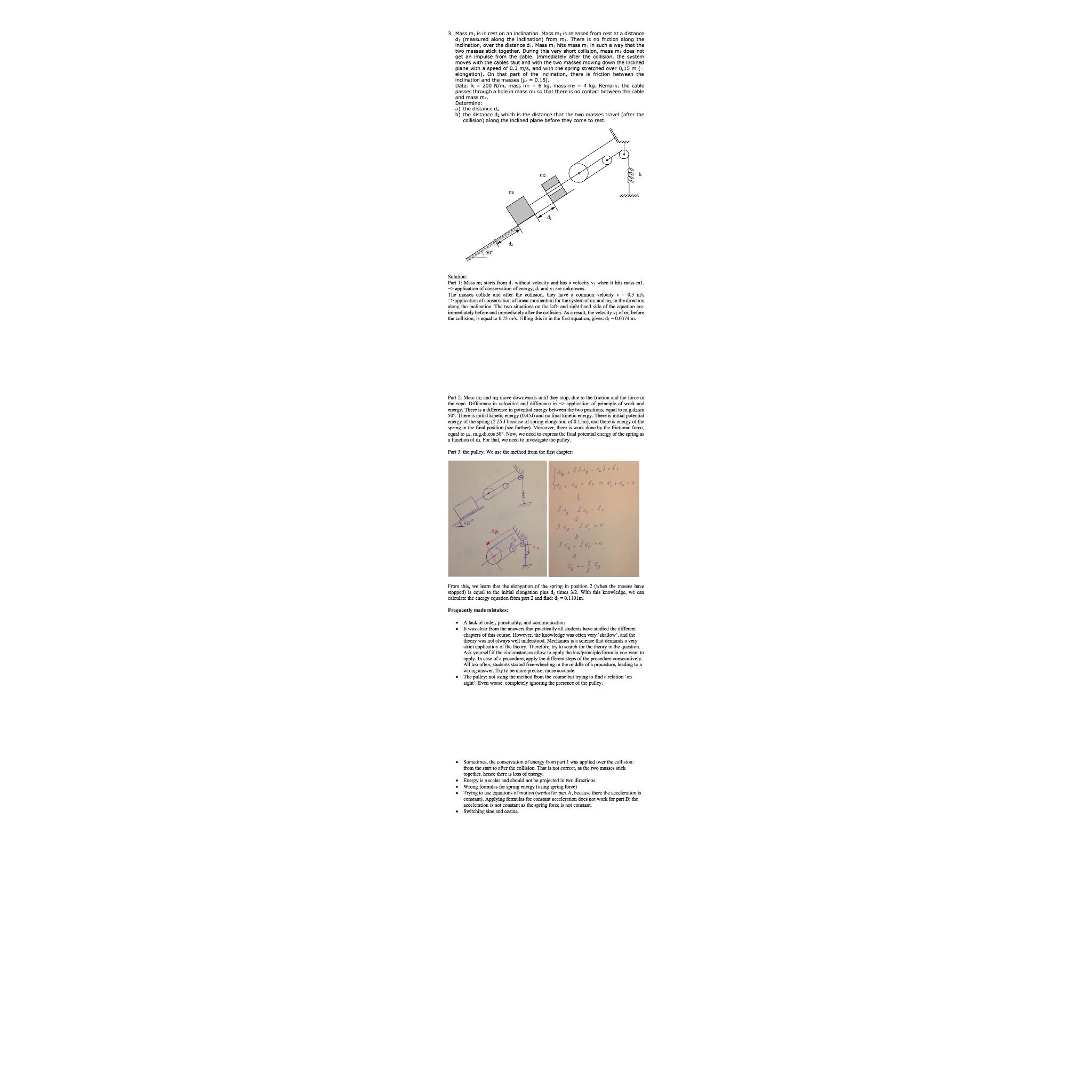Answered step by step
Verified Expert Solution
Question
1 Approved Answer
3. Mass m is in rest on an inclination. Mass m2 is released from rest at a distance di (measured along the inclination) from

3. Mass m is in rest on an inclination. Mass m2 is released from rest at a distance di (measured along the inclination) from mi. There is no friction along the inclination, over the distance di. Mass m hits mass m; in such a way that the two masses stick together. During this very short collision, mass mi does not get an impulse from the cable. Immediately after the collision, the system moves with the cables taut and with the two masses moving down the inclined plane with a speed of 0.3 m/s, and with the spring stretched over 0,15 m (= elongation). On that part of the inclination, there is friction between the Inclination and the masses (0.15). Data: k = 200 N/m, mass m = 6 kg, mass m> 4 kg. Remark: the cable passes through a hole in mass m> so that there is no contact between the cable and mass m. Determine: a) the distance d b) the distance d2 which is the distance that the two masses travel (after the collision) along the inclined plane before they come to rest. mi www. Solution: Part 1: Mass my starts from di without velocity and has a velocity vi when it hits mass ml. application of conservation of energy, di and vi are unknowns. The masses collide and after the collision, they have a common velocity v -0.3 m/s ->application of conservation of linear momentum for the system of mi and me, in the direction along the inclination. The two situations on the left- and right-hand side of the equation are: immediately before and immediately after the collision. As a result, the velocity vi of mi before the collision, is equal to 0.75 m/s. Filling this in in the first equation, gives: d -0.0374 m. Part 2: Mass m; and my move downwards until they stop, due to the friction and the force in the rope. Difference in velocities and difference in application of principle of work and energy. There is a difference in potential energy between the two positions, equal to m.g.dz.sin 50. There is initial kinetic energy (0.45J) and no final kinetic energy. There is initial potential energy of the spring (2.25 J because of spring elongation of 0.15m), and there is energy of the spring in the final position (see further). Moreover, there is work done by the frictional force, equal to a. m.g.dz.cos 50. Now, we need to express the final potential energy of the spring as a function of d. For that, we need to investigate the pulley. Part 3: the pulley. We use the method from the first chapter. 40+2(0-4)=4 + 2 3-24 J 34240 35.2010 B From this, we learn that the elongation of the spring in position 2 (when the masses have stopped) is equal to the initial elongation plus de times 3/2. With this knowledge, we can calculate the energy equation from part 2 and find: d = 0.1101m. Frequently made mistakes: . A lack of order, punctuality, and communication It was clear from the answers that practically all students have studied the different chapters of this course. However, the knowledge was often very 'shallow', and the theory was not always well understood. Mechanics is a science that demands a very strict application of the theory. Therefore, try to search for the theory in the question. Ask yourself if the circumstances allow to apply the law/principle/formula you want to apply. In case of a procedure, apply the different steps of the procedure consecutively. All too often, students started free-wheeling in the middle of a procedure, leading to at wrong answer. Try to be more precise, more accurate. The pulley: not using the method from the course but trying to find a relation on sight. Even worse: completely ignoring the presence of the pulley. Sometimes, the conservation of energy from part 1 was applied over the collision: from the start to after the collision. That is not correct, as the two masses stick together, hence there is loss of energy. Energy is a scalar and should not be projected in two directions. Wrong formulas for spring energy (using spring force) Trying to use equations of motion (works for part A, because there the acceleration is constant). Applying formulas for constant acceleration does not work for part B: the acceleration is not constant as the spring force is not constant. Switching sine and cosine.
Step by Step Solution
There are 3 Steps involved in it
Step: 1

Get Instant Access to Expert-Tailored Solutions
See step-by-step solutions with expert insights and AI powered tools for academic success
Step: 2

Step: 3

Ace Your Homework with AI
Get the answers you need in no time with our AI-driven, step-by-step assistance
Get Started


